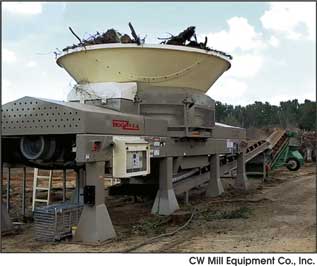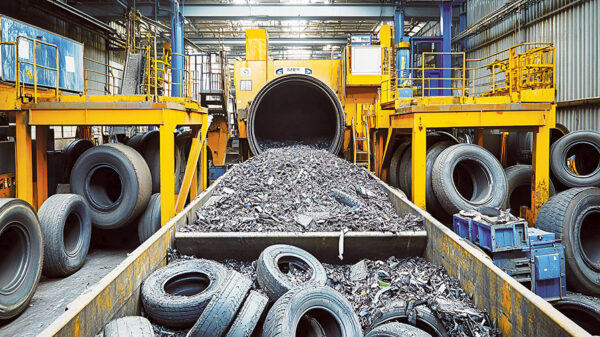by MARY M. COX
Manufacturer List
|
In 2013, America composted about 87 million tons of material, equivalent to a 34.3 percent recycling rate. On average, 1.51 pounds of our individual waste generation of 4.40 pounds per person per day was recycled and composted, according to the Environmental Protection Agency (EPA).
Chippers and grinders are often used to reduce wood and green waste and CW Mill Equipment has been manufacturing grinders for over 40 years. CW Mill’s HogZilla® grinders are configured with either tub or horizontal feed systems mounted on self-propelled tracks, trailers and stationary frames.
The company offers 20 standard HogZilla models. “Diesel engines are the most popular power source facilitating portability, but electric power is very popular even in high horsepower systems due to the simplified overall design. HogZilla’s heavy construction, quality components, and proven performance have stood the test of time in a wide variety of applications such as land clearing, mulch production, and many other waste recycling efforts,” Brian Bergman, operations manager, commented.
He added, “Hogzilla track options have become extremely popular with many land clearing contractors and those involved in the wood and green waste recycling industry. A HogZilla on tracks is unparalleled in production and mobility. Hydrostat pumps driven off the front of the engine allow grinding to continue while moving the HogZilla. Most other grinders require the operator to stop grinding before moving the grinder. The loader/excavator operator can stay in the cab while moving the track-mounted HogZilla to different locations using a remote control.”
There are many variations in wood, green waste, end product preferences and job sites. Similarly, there are numerous HogZilla machines with many options available, including mounted grapple loaders. Bergman said, “Each of our grinders can be customized to suit individual customer needs, making HogZilla tub and horizontal feed grinders a very popular choice for grinding professionals.”
DuraTech Industries, in business since 1966, offers the TC-12 and TC-15 tree chippers. The powerful chippers can grind logs up to 12” and 15” in diameter and both employ a 129 hp (96 kW) CAT C4.4 engine. The TC-12 also has a Kubota V3800 88 hp (74 kW) engine option.
“We offer a large tree chipper, TC-15, with the same advanced and powerful technology utilized in our grinders,” said Bob Strahm of DuraTech Industries. “We entered the market with our TC-12 tree chipper and we’ve now expanded our product line even further.”
Both chippers feature a spring-loaded feed wheel with adjustable down pressure. Also, an optional height sensor automatically adjusts the feed roller to material size and an optional hydraulic gathering winch is also part of the machine. A hydraulic 2 feed roller system feeds the (4) 4.5” knives, designed to chip wood waste.
The high-powered units discharge debris 360° from the hydraulic rotating adjustable chip spout, allowing a user to alter chip disposal. They also include multiple safety features like the innovative hopper safety light bars, with easy and instant shut down. Two E-stop switches, a disc hood closed proximity switch and a breakaway brake switch to ensure the safety of the operator are included as well.
“Safety is a major concern when operating chippers,” said Strahm. “The precautions installed on both of our tree chippers allow users to operate safely and benefit from full use of all the features.” The tree chipper is available with a pintle or ball hitch and can easily be towed to a job-site.
Weima offers a line of shredding equipment specifically for the wood industry and products range in size, providing many options for various operations and budgets. “For example, small cabinet shops may only need our WLK4 single-shaft shredder, for handling end cuts or blocks. A larger operation may need our WLK15, which has a larger hopper and rotor and so it can handle much larger scrap. We also offer horizontal wood shredders in various sizes for skeletons, rippings and other linear waste with infeed vibratory conveyors,” said Madison Burt, vice president of sales.
He stated that WEIMA shredders are unique because products can be customized to fit a client’s specific application – whether that involves size, RPM, and/or infeed/discharge methods. “Proper set-up of a shredder and location in the facility can eliminate the need to handle waste repeatedly. This increases efficiency in the overall operation. We also offer a variety of rotor types, knife types, and screen sizes to make sure the throughput is exactly what our customer requires. We’ve had 30 years in the industry to fine tune our shredding systems and we also manufacture shredders that process all kinds of manufacturing waste, including paper, plastic, fiber and more,” Burt explained.
He said his customers report an astronomical expenditure for waste removal. “When you shred leftover wood, you can maximize use of each dumpster and pay less for fewer loads hauled from the work site. WEIMA can offer a reduction ratio of 4:1 in some cases, which can be a very helpful savings. It might be possible to trim cost for personnel that handle the waste. We can meet with a warehouse foreman, for example, to ensure your handling process is as efficient as possible,” stated Burt.
In the rebound since the 2008 housing construction crisis, Audrey Brewer, marketing manager, has noticed an uptick in demand for shredders. “With new production comes the need to shred items such as molding, railing, decks, cabinets, and doors. Also, as the ‘green movement’ continues, more companies realize it can be lucrative, manufacturing in an environmentally sound manner. Integrating scrap wood into a production line is a great way to do so. Resources are finite. It is great when wood can be diverted from a landfill and instead, converted to a useful commodity like mulch, animal bedding, or boiler fuel,” Brewer said.
Published in the August 2016 Edition of American Recycler News









